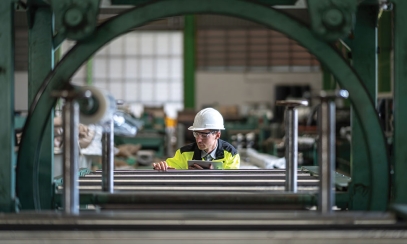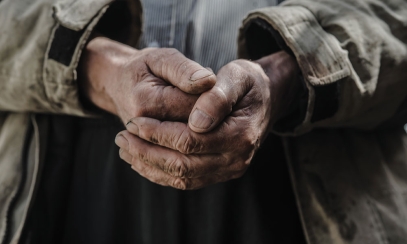
Vatican II Part 6: Sacrosanctum Concilium: Part 1
A Series on Vatican II
A Series on Vatican II
Finding the source and summit of the Christian life
So far in this series we have reflected on the Second Vatican Council’s Dogmatic Constitutions Dei Verbum and Lumen Gentium. Through these documents we have seen that God has not only revealed Himself to us through His Son Jesus Christ, but has also formed us into the People of God united in Christ, thus allowing us to share intimately in the very life of the Trinity. Now, we must focus our attention on how we respond to these great gifts. Worship is the most appropriate response to God’s gift of His own life in Christ.
As Catholics, we worship God through participating in the liturgy. This is the theme of The Constitution on the Sacred Liturgy, also known by its Latin name, Sacrosanctum Concilium. It has been called by Pope John Paul II the ‘first fruit’ of the Second Vatican Council. Indeed, promulgated on December 4, 1963, it was actually the first document produced by the Council. The purpose of this document was to lead all the faithful to reflect more fully on Jesus’ call to worship God in spirit and in truth and to rediscover the treasures contained in the liturgy. (cf. John 4: 23) According to Sacrosanctum Concilium the sacred liturgy is the “summit toward which the activity of the Church is directed; and the same time, it is the fountain from which all her powers flow.” (SC 10) The desired fruit of this document and the liturgical reforms that followed was that “all the faithful be led to that full, conscious and active participation in liturgical celebrations which is demanded by the very nature of the liturgy, and to which the Christian People ... have a right and obligation by their baptism.” (SC 14)
Before we can understand how the liturgy is the source and summit of the Church’s life, we must first understand just what the liturgy is. The word liturgy comes from the Greek word for “public work of the people,” and “means the participation of the People of God in the ‘work of God.’” (CCC 1069) The “work of God” is our redemption. The redemption of mankind was won by the suffering, death and resurrection of Jesus Christ. However, it is up to each individual to allow the fruits of this redemption to be personally applied to his or her soul. This is accomplished principally through participation in the prayers and sacraments, which make up the liturgy. The Council Fathers put it beautifully when they wrote, “The liturgy, ‘through which the work of of our redemption is accomplished,’ most of all in the divine sacrifice of the Eucharist, is the outstanding means that enables the faithful to express in their lives and manifest to others the mystery of Christ and the real nature of the Church.” (SC 2) It is fitting that in ancient Hebrew, Greek, and Latin the same word is used for both ‘work’ and ‘worship,’ for worship is the supreme work of the People of God.
While recognizing that the liturgy is not the only work of the Church, the Fathers of the Council emphasize that the liturgy is the supreme work of the Church by referring to the liturgy as the ‘summit of all her works.’ When we participate in the liturgy we are given “a foretaste of that heavenly liturgy which is celebrated in the holy city of Jerusalem toward which we journey as pilgrims, where Christ is sitting at the right hand of God, minister of the holies and of the true tabernacle.” (SC 8) Worship is the only work of the Church that is eternal, for in heaven there will be no more need for the corporal and spiritual works of mercy. Thus, worship is the height to which all her other works should lead. Indeed, all the works in which the People of God are engaged, large and small, find their fulfillment when they are offered as worship and presented to God in the liturgy as spiritual sacrifices. “Every liturgical celebration, because it is an action of Christ, is a sacred action surpassing all others. No other action of the Church can equal its efficacy by the same title and to the same degree.” (SC 7)
Not only is the liturgy the summit of the Church’s life, but it is also the source. All life and holiness comes to us through Jesus Christ. Through the liturgy we come into contact with Christ in a unique way. It is Christ’s presence in the liturgy that is the very fountain or wellspring from which all the Church’s powers and energies of life and holiness flow. As The Constitution on the Sacred Liturgy states, “From the liturgy, and especially from the Eucharist, grace is poured forth upon us as from a fountain, and sanctification of men in Christ and the glorification of God to which all other activities of the Church are directed, as toward their end, are achieved with maximum effectiveness.” (SC 10) Since the liturgy is the source of the Church’s very life, we as Catholics must allow the grace of the liturgy to permeate and transform every aspect of our lives. For this to happen, we must dispose ourselves to be open to the graces being poured out.
How is Christ present in the Mass?
Jesus is present in the holy sacrifice of the Mass:
In the person of the priest: The priest presides at the Eucharistic sacrifice in persona Christi – in the person of Christ. By the indelible character on his soul he has received in the sacrament of Holy Orders, the priest acts in the power and place of Christ Himself when he pronounces the words of consecration during the Eucharistic prayer.
In the community of the faithful: Christ promises that “wherever two or three are gathered together in my name, there am I in the midst of them.” (Matt 18:20) When the faithful come together to participate in the commemoration of the Paschal sacrifice, Christ is present among us.
In the Liturgy of the Word: When the Scriptures are read in church, God Himself speaks to His people, and Christ, present in His Word, proclaims His Gospel. (SC 9)
In the Eucharist: In the Most Holy Eucharist, Jesus is truly and substantially present – Body, Blood, soul and divinity. This presence is described as presence par excellence, because He is truly present under the appearance of bread and wine. For this reason, we genuflect to the tabernacle where the Blessed Sacrament is reserved and are encouraged to worship and adore Him in Eucharistic adoration.
How to get the most out of Mass
The following are a few practical suggestions to help make “full, conscious and active participation” at the weekly liturgical celebration of Mass a little easier:
- Be attentive. Listen to the prayers of the Mass. Pay close attention during the Liturgy of the Word. Raise your mind to God during the Eucharistic prayer. The Mass itself can teach us a great deal about the meaning of the celebration, if we take care to be attentive. (If you want to learn more, there are many good books out there on the meaning of the Mass.)
- Reflect on the readings ahead of time. The Church recommends reading Scripture every day. Why not make the Church’s ‘reading plan’ your own by looking over the daily readings? This will make it easier to pay attention during the Liturgy of the Word.
- Cultivate a sense of the sacred. Recall that you are in Christ’s presence when you enter the church. Show respect by keeping a sacred silence as far as possible in this holy place. Try to leave your distractions at the door and call on the Holy Spirit!
What is the Divine Office?
Since the Second Vatican Council, many of the lay faithful have responded generously to the Council Fathers’ encouragement to “recite the divine office, either with the priests, or among themselves, or even individually.” (SC 100) In fact, in recent years, it has become increasingly common to encounter a layperson carrying a breviary, or to witness groups of the laity, often led by their local pastors, reciting the Liturgy of the Hours in small groups in their local parish churches.
What, then, is the Divine Office? The Church is engaged in unceasing praise and worship of God and intercession for man’s salvation. This is accomplished chiefly through the celebration of the Eucharist, “but also in other ways, especially by praying the Divine Office.” (SC 83) The other common name for the Divine Office, the “Liturgy of the Hours,” reveals the purpose of this prayer. The Divine Office aims at sanctifying the whole day, with prayers for the morning, midday, evening and night. It has been described as the ‘setting’ for the ‘jewel’ of the Mass, preparing one for the holy sacrifice, and extending the fruits of one’s participation in it over the course of the day.
Ask your local pastor about praying the Divine Office. You might begin by praying one of the hours, such as morning prayer, privately, or join a family member or friend to pray the night prayer of the Church, called Compline.
Sr. Maria Gemma Martek O.P., and Sr. Elizabeth Ann O’Reilly, O.P. are Dominican Sisters of Mary, Mother of the Eucharist, Ann Arbor.



